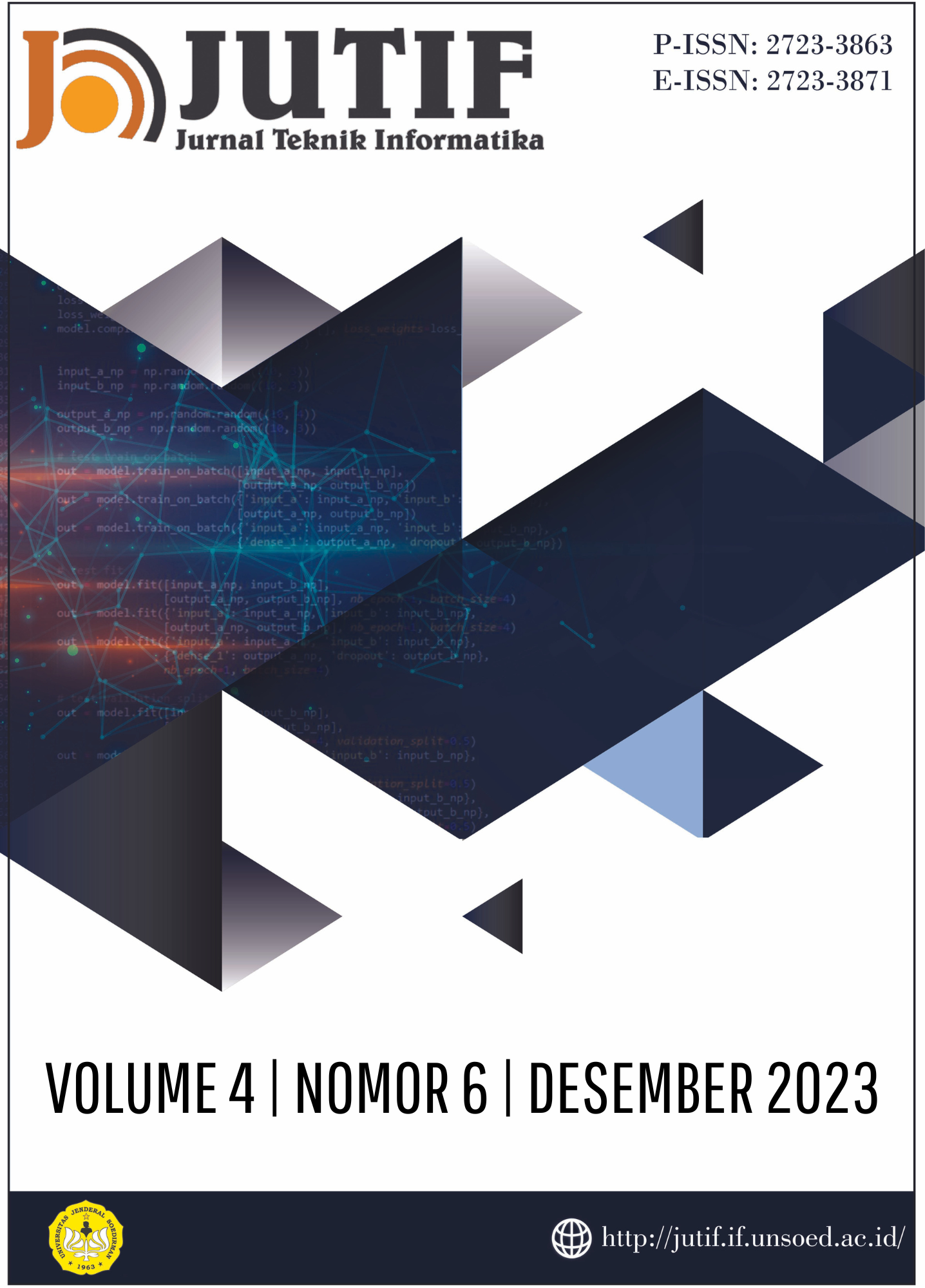REAL-TIME DROWSY FACE DETECTION FOR ONLINE LEARNING BASED ON RANDOM FOREST AND DECISION TREE ALGORITHMS
DOI:
https://doi.org/10.52436/1.jutif.2023.4.6.1554Keywords:
decision tree, eye aspect ratio, mouth aspect ratio, online learning, random forestAbstract
In the current era, technology regarding artificial intelligence has developed rapidly and has been used in various areas of life. Face detection is one of the applications of Artificial Intelligence. This research aims to detect students' faces during the online learning process and succeeded in getting positive feedback when tested on students. Student detection includes drowsy and alertness. The method is via webcam in real-time so that the screen will show whether the student is drowsy or alert. In the trial, the teacher can find out who is in a drowsy and alert condition. On the other hand, students can find out that they fall into the drowsy or alert category. So that both parties immediately respond to what should be done based on the classification results. The algorithms used are Decision Tree and Random Forest. The accuracy results of the Random Forest algorithm are better than the Decision Tree algorithm, namely 65 percent, while the Decision Tree algorithm is 58 percent. The division of training data and test data uses a Kfold of 5. When Kfold is equal to 2, both algorithms have the highest accuracy, where Random Forest has an accuracy of 85 percent, and Decision Tre has an accuracy of 65 percent.
Downloads
References
G. A. Wani, R. P. Singh, and M. Mehra, “Analysis of Driver Drowsiness Using Convolution Neural Network Algorithms,” Int. J. Innov. Res. Eng. Manag., vol. 9, no. 2, pp. 84–90, 2022, doi: https://doi.org/10.55524/ijirem.2022.9.2.11.
V. Naren Thiruvalar and E. Vimal, “A comparative analysis on driver drowsiness detection using CNN,” Int. J. Nonlinear Anal. Appl, vol. 12, no. November, pp. 2008–6822, 2021, [Online]. Available: http://dx.doi.org/10.22075/ijnaa.2021.5894.
Z. Jie, M. Mahmoud, Q. Stafford-Fraser, P. Robinson, E. Dias, and L. Skrypchuk, “Analysis of yawning behavior in spontaneous expressions of drowsy drivers,” Proc. - 13th IEEE Int. Conf. Autom. Face Gesture Recognition, FG 2018, pp. 571–576, 2018, doi: 10.1109/FG.2018.00091.
A. L. A. Ramos, J. C. Erandio, E. M. Enteria, N. Del Carmen, L. J. Enriquez, and D. H. Mangilaya, “Driver Drowsiness Detection Based on Eye Movement and Yawning Using Facial Landmark Analysis,” Int. J. Simul. Syst. Sci. Technol., pp. 1–8, 2019, doi: 10.5013/ijssst.a.20.s2.37.
C. R. Manjunath, K. S. Krishna, K. B. Sree, and K. N. Ramyatha, “Driver Drowsiness Detection Alert System Using Haar Method,” Smart Innov. Syst. Technol., vol. 273, no. 7, pp. 380–389, 2022, doi: 10.1007/978-3-030-92905-3_47.
Chilaka Anvitha, Mohammed Muzammil, Soundaraya. A, and Raghu Kumar, “Driver Drowsiness Detection Using Machine Learning,” Int. J. Adv. Res. Sci. Commun. Technol., vol. 2, no. 2, pp. 314–319, 2022, doi: 10.48175/ijarsct-5456.
K. Rabiah and M. Khariol, “Driver Drowsiness Detection with an Alarm System using a Webcam,” vol. 4, no. 1, pp. 87–96, 2023.
H. Pranoto, A. Adriansyah, A. Wahab, and D. Feriyanto, “Integrated Speed and Driver Fatigue Detected with Method Image Processing,” Int. J. Adv. Technol. Mech. Mechatronics Mater., vol. 1, no. 1, pp. 6–12, 2020, doi: 10.37869/ijatec.v1i1.7.
A. Araballi and S. Shinde, “Real Time Implementation of Driver Drowsiness Monitoring System Using SVM Classifier,” Int. J. Eng. Manuf., vol. 13, no. 3, pp. 48–54, 2023, doi: 10.5815/ijem.2023.03.05.
X. Chen and B. Zhang, “A XGBoost Algorithm-based Fatigue Recognition Model Using Face Detection,” pp. 1–7, 2023.
P. Pattarapongsin, B. Neupane, J. Vorawan, H. Sutthikulsombat, and T. Horanont, “Real-time Drowsiness and Distraction Detection using Computer Vision and Deep Learning,” ACM Int. Conf. Proceeding Ser., 2020, doi: 10.1145/3406601.3406638.
G. Cao and H. Peng, “The Decision of Fatigue State Based On Characteristics’ Fuzzy Fusion,” no. Iccia, pp. 295–298, 2016, doi: 10.2991/iccia-16.2016.61.
Y. Ji, S. Wang, Y. Lu, J. Wei, and Y. Zhao, “Eye and mouth state detection algorithm based on contour feature extraction,” J. Electron. Imaging, vol. 27, no. 05, p. 1, 2018, doi: 10.1117/1.jei.27.5.051205.
E. Poornima, R. P. Ram Kumar, S. Katukam, V. V. Pericherla, and S. K. Birelli, “A Real-Time IoT-based Model to Detect and Alert Security Guards’Drowsiness,” E3S Web Conf., vol. 391, pp. 1–6, 2023, doi: 10.1051/e3sconf/202339101151.
C. Dewi, R. C. Chen, X. Jiang, and H. Yu, “Adjusting eye aspect ratio for strong eye blink detection based on facial landmarks,” PeerJ Comput. Sci., vol. 8, no. 2020, pp. 1–21, 2022, doi: 10.7717/peerj-cs.943.
A. Krizhevsky, I. Sutskever, and G. E. Hinton, “Imagenet classification with deep convolutional neural networks,” Adv. neural Inf. Process. Syst., pp. 1097–1105, 2012, doi: 10.1201/9781420010749.
U. Lahoti, R. Joshi, N. Vyas, K. Deshpande, and S. Jain, “Trends in Computer Drowsiness Detection System for Online Courses,” Int. J. Adv. Trends Comput. Sci. Eng., vol. 9, no. 2, pp. 1930–1934, 2020.
D. Li, Z. Cui, F. Cao, G. Cui, J. Shen, and Y. Zhang, “Learning State Assessment in Online Education Based on Multiple Facial Features Detection,” Comput. Intell. Neurosci., vol. 2022, 2022, doi: 10.1155/2022/3986470.



























